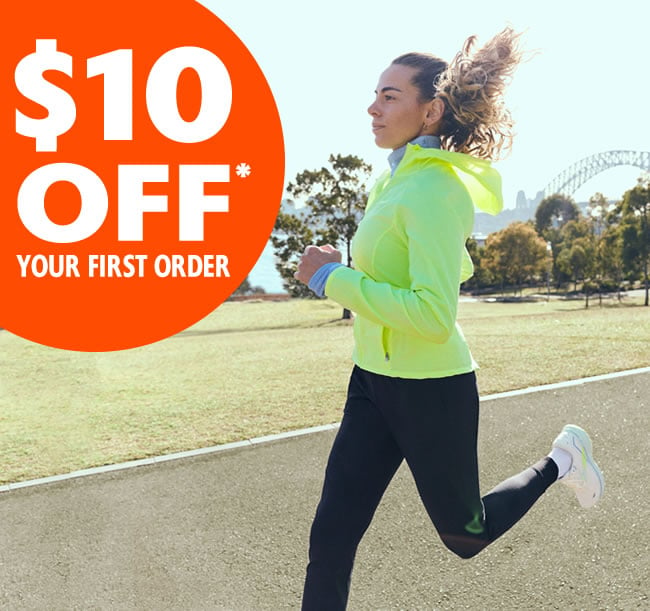The Smarter Way To Carry Water On Your Runs

If you regularly run more than 5K you’ve probably asked yourself, “How the heck do I carry water on my runs?” – that is without the annoying slosh slosh of water throwing you off balance or getting in the way of reaching a runner’s high.
Handheld bottle
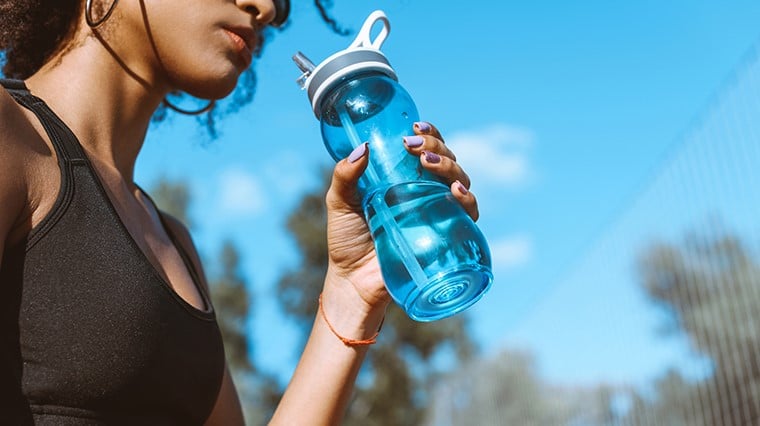
The good ol’ trusty handheld drink bottle. Chances are you either love them or hate them. Love them for the no-fuss, sip-and-go convenience, yet hate how they can weigh you down and even hinder your running form as you pump your arms forward and back. Here’s what to look out for to get your perfect fit.
Let's make one-use plastic bottles history
First things first – one-use plastic bottles just aren’t economical or eco-friendly. Reusable is the way to go to reduce landfill, keep our oceans clean and avoid a lighter wallet over time. The sea turtles will thank you for it.
Ergonomic shape
Sports brands like Adidas and Nike have released reusable, ergonomic styles with strategically placed notches for comfy carrying and a natural feel in your hands – so you can focus more on setting your next PB and less on the death-grip you have on your bottle.
Storage
Many running bottles include straps to lock the bottle in place or even accessories pockets to stash your keys, gels, phone or whatever other little treasures you need.
Other features
Leak-free valves - when the going gets tough you'll be happy you've preserved every drop.
Handheld bottle tip
Unless you’re carrying two small bottles in each hand for a balanced weight, a singular handheld bottle may make you feel weighted unevenly.
Switch the water bottle between your hands about every 10 minutes to give each hand a break and choose ergonomic or adjustable hand strap designs to prevent wrist strain.
Suitable for: Short runs, especially where there is opportunity to get a refill.
Hydration belt / Running waistpack
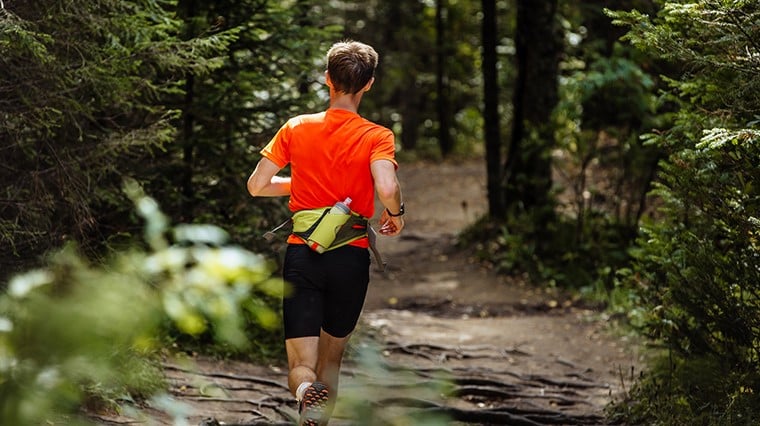
The right running waistpack is your swiss army knife of hydration carrying gear, but you want it to sit on your body just-right with a slim profile. They keep your hands free, ensure your shoulders and back stay feeling light and keep your back open to the air so your sweat can do its thing to keep you cool.
Bounce-free fit
Although a properly fitted waistpack can be your favourite running kit, it can be a real bummer to have a waistpack that won’t stay put.
Lightweight, streamlined and minimalist styles help keep unwanted race day bounce to a minimum and can be adjusted to suit your body shape. Stretchy fabrics allow the belt to move with you comfortably.
Sweat management
Look out for breathable, sweat-wicking materials to keep your cool and avoid irritation, because nobody wants a sweaty hydration belt clinging to their skin!
Storage
Stretchy pockets provide a zip-up home for your essentials like gels, phone and keys without adding too much bulk.
Other features
For an added bonus, some running waistpacks have reflective details so you can shine on your night runs. Aim for chafe-free materials to keep your skin happy.
Hydration belt tip
As a fitting tip, the hydration belt should hug snuggly around your waist as opposed to riding low on your hips where it may hinder your running form or slide off around your ankles! It may take some tweaking and adjusting to find the sweet spot.
Suitable for: Racing and training.
Hydration pack
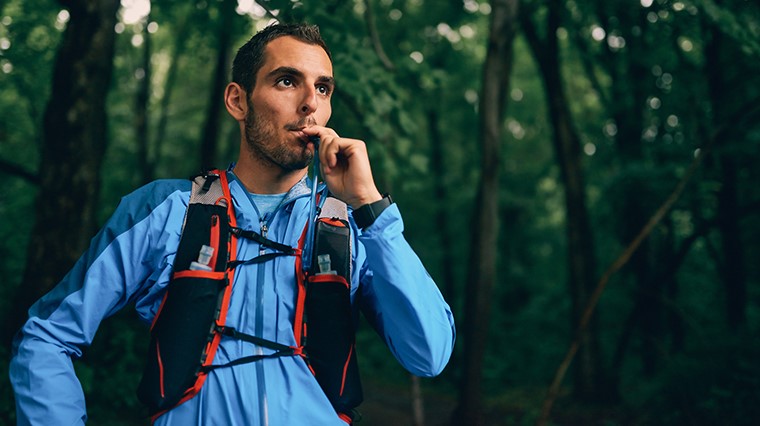
The principle behind a running vest pack/running backpack is a hydration system that you wear, rather than carry. The best styles contour to your body and are streamlined so there’s little interference to your running performance.
Running vest pack vs running backpack
Hydration running pack styles vary based on the expected distance/time they’re in use as well as to accommodate the conditions (e.g. more storage space is needed in cold or rainy weather to stash extra layers).
Minimalist running vest packs strip back on non-essentials and mould close to your body like a second-skin – fantastic if the weather is all sunshine and lollipops, but not so good if you get caught out in a storm unprepared.
Running backpacks act as the bridge between running vest packs and hiking packs. They’re similar to a hiking pack in that they have more cargo space (for nutrition, layers etc.), but with a sleeker, running-specific fit for longer trail runs.
Soft flasks vs rigid bottles
Hydration storage systems vary between styles of running vest packs and running backpacks. Some
feature soft flask pockets on the harness system (front shoulder straps) for
convenient access, whereas others have rigid bottle holders on the back or offer a combination of water storage solutions.
This is up to personal preference – soft flasks are less puncture resistant than rigid bottles (which would be a drama if you trip in an isolated area!) but sit more naturally to your body and may compress as you drink to reduce the slosh factor.
Hydration reservoir
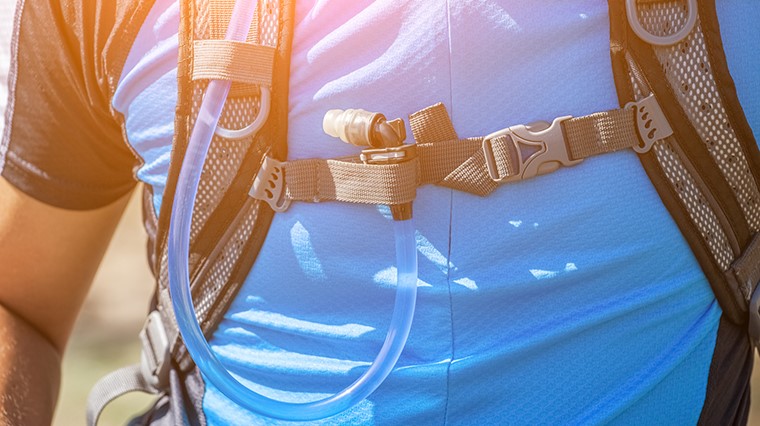
Running backpacks commonly come with a hydration reservoir with a hose/tube that clips to your harness system for a no-fuss, sip-and-run experience. Many have a specific hydration reservoir sleeve, and the bite valve (mouth piece) can be ‘locked’ to prevent leakage on the fly.
This flexible ‘bladder’ has a greater liquid capacity than the former soft flask or rigid bottle options, and yet with the water distributed evenly, it can feel surprisingly lightweight on your back. It’s easy to underestimate just how heavy water can be!
The downside is they can be trickier to clean and fill up than rigid bottles and take a little getting used to, but from personal experience they’re well worth it for longer distances.
Sweat management
Opt for styles with a mesh back and ventilation channels for on-the-go cooling. Vests that you wear higher up on your body help prevent sweat build-up against your lower back, with the trade-off usually being less storage space.
Storage
Cargo room depends on the specific style of pack – from minimalistic vest styles for only the bare essentials and a barely there feel, to running backpacks capable of tackling an ultra marathon. Stretchy pockets help keep your running pack slim and hold your accessories close to your body for ease of movement.
Front shoulder straps usually have a pocket to tuck away your phone – making it easy to take a scenic snap, sweaty-and-lovin’-it selfie for Instagram or to update your mates on your trail run progress.
Other features
Stabilising chest straps improve the bounce-free fit and ergonomic harness systems keep you comfy on the move. Hydration packs with reflective details offer piece of mind on your runs by keeping you visible in the low light hours.
Running pack tip
Check the liquid capacity and gear capacity of your hydration pack before
you buy to ensure it suits your specific needs.
Consider the distance you intend to run, whether the area is remote or well-trafficked, the temperature/conditions and availability of clean water (trail races may have aid stations to refill on route).
Be aware you may need to drink more on hot weather runs. Throw some ice cubes into your hydration bladder for a cool kick.
Suitable for: Ultra running, trail running and even long beach runs if the crashing waves and salty air are more your thing.
